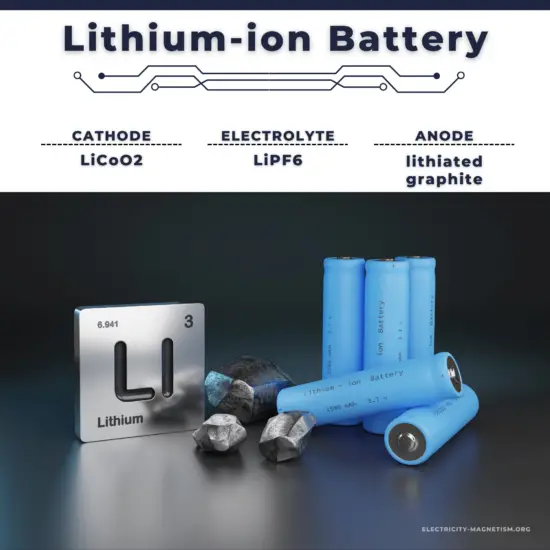30-second summary
Lithium-ion Battery
A lithium-ion battery, also known as the Li-ion battery, is a type of secondary (rechargeable) battery composed of cells in which lithium ions move from the anode through an electrolyte to the cathode during discharge and back when charging.
There are several specific advantages to lithium-ion batteries. The most important advantages are their high cell voltage, high energy density, and no memory effect.
Lithium-ion batteries are used in many laptop computer batteries, cordless power tools, certain electric cars, electric kick scooters, most e-bikes, portable power banks, and LED flashlights.
The overall reaction during discharge is:
C6Li + CoO2 ⇄ C6 + LiCoO2

Lithium-ion Batteries and Grid Energy Storage
A battery storage power station is a type of energy storage power station that uses a group of batteries to store electrical energy. Battery storage is the fastest responding dispatchable source of power on grids, and it is used to stabilize grids, as battery storage can transition from standby to full power within milliseconds to deal with grid failures. At full-rated power, battery storage power stations are generally designed to output for up to a few hours.
Lithium-Ion (Li-I) batteries are the most common type of rechargeable batteries. Sodium-ion batteries are a cheap and sustainable alternative to lithium-ion because sodium is far more abundant and cheaper than lithium, but it has a lower power density. However, they are still in the early stages of their development. Lead-acid batteries, together with the nickel-cadmium batteries listed below, are among the oldest, best-known, and most widely used batteries. Although Li-ion batteries are slowly beginning to displace from some applications, there are areas where lead and alkaline batteries are irreplaceable. Compared to Li-ion batteries, they excel especially in low-temperature resistance, safety, and price.
Lithium-ion batteries are also frequently discussed as a potential option for grid energy storage, although they are not yet cost-competitive at scale. Lithium batteries show the largest market growth of all other batteries and have successfully displaced the competing systems. Lithium secondary batteries (lithium-ion batteries) provide multiple reversible transformation of chemical energy into electrical energy so that these batteries can be often used. Lithium-ion batteries, unlike conventional batteries, do not have a memory effect (loss of capacity by not complete loading/unloading) and achieve high efficiency of up to 95% (ratio of discharge to charge amount). The problem with these batteries is their lifespan, which is typically defined as the number of full charge-discharge cycles to reach a failure threshold in terms of capacity loss or impedance rise. After 500 cycles, the capacity of lithium-ion batteries begins to drop, and the capacity is reduced to around 50% after 1200-1500 discharge cycles. One of the largest Li-I storage plants in the world is the 48 MW, 12 MWh Gyeongsan Substation in South Korea, which became operational in January 2016.

